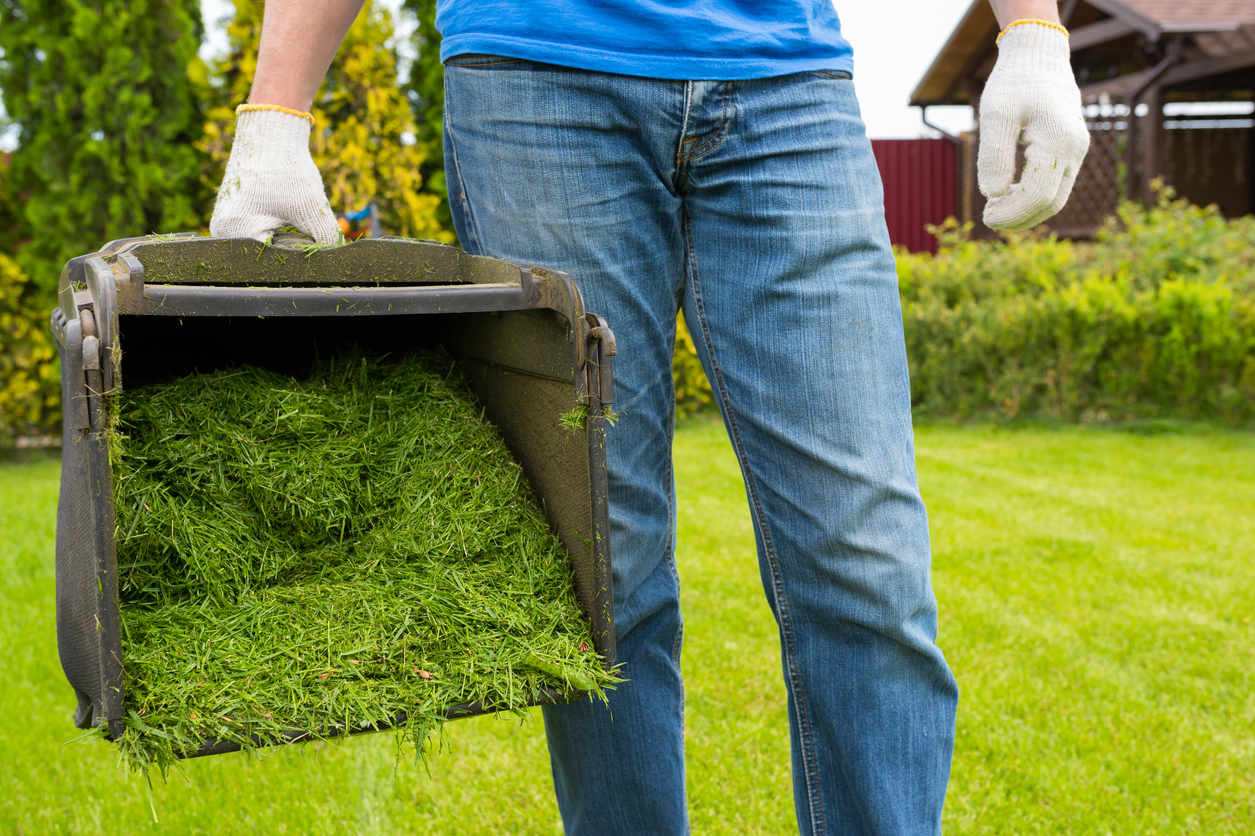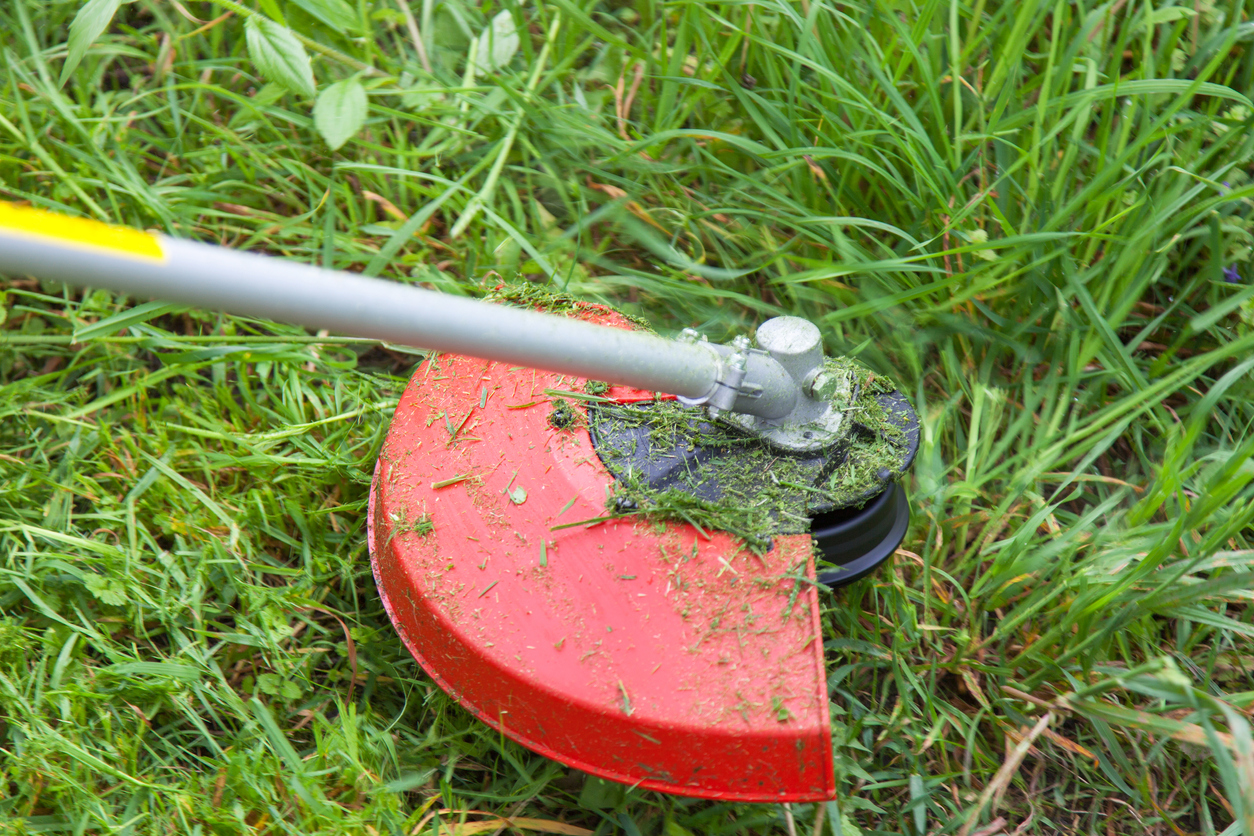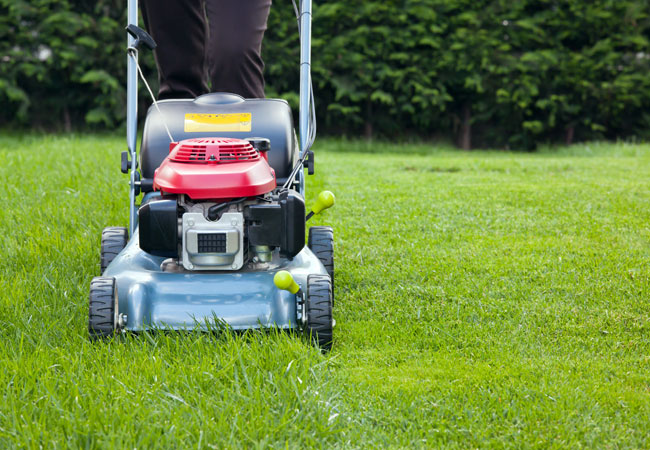We may earn revenue from the products available on this page and participate in affiliate programs. Learn More ›
If you have a sprawling lawn it might feel like the more you mow, the more it grows. But keeping your lawn neatly manicured is a must for optimal enjoyment and curb appeal. So rather than go at it in a haphazard manner, follow our tips for how to mow a lawn quickly and smoothly while still ensuring the health of your grass. Then kick off your shoes and love your lawn!
Tools & Materials
Bobvila.com may earn a commission from purchases made through these links.
STEP 1: Trim and edge the grass.
Before you get behind the lawn mower, trim and edge your yard to reduce the risk of damaging trees, plants, and hardscaping by getting too close to them with your mower. Plus, weed whacking around obstacles like trees, mailboxes, and fences will make mowing the lawn go faster because you won’t have to maneuver around them.
Edging garden beds will prevent turf grass from encroaching onto your landscaping plants, and you won’t need to continually pull that grass back by hand.
STEP 2: Mow often and early.

Although there can be a few good reasons not to mow the lawn, in general, consistency keeps your turf happy and healthy.
- Resist the temptation to let your lawn get knee-high just to save mowing time and then give it a crew cut. Mowing more than one-third of the length of grass blades prevents optimal photosynthesis.
- Make a point of mowing grass approximately every 5 days in early spring and late fall—your lawn’s growth-spurt periods.
- If you are late in mowing, raise your blade height to keep from taking off too much plant tissue. Then, mow the yard again in a couple of days if you’d like a shorter lawn.
- Keep in mind that the best time to mow is in mid-morning, between the hours of 8 a.m. and 10 a.m. Early morning dew will have evaporated, but grass won’t be limp from harsh midday sun.
STEP 3: Change direction each time you cut the grass.
Once you fall into a routine for mowing the lawn, you might be inclined to always cut exactly the same way. Don’t! To reduce turf wear and soil compaction, change things up and mow in a different direction week to week.
Position the mower horizontally and follow a straight line this week, for example, then mow vertically next week. You can even try to master the beautiful diagonal stripes of a professional baseball diamond, or mow in circles like a Zen labyrinth. Just be sure to switch it up.
STEP 4: Make smart use of clippings.

There are two ways to use lawn clippings:
- Some people collect and bag grass clippings in order to prevent a layer of thatch developing at the grass roots. If you choose to collect clippings, add them to your compost pile—they’ll contribute to beautifully rich soil for landscaping and potted plants.
- However, as long as you mow a lawn regularly so that clippings aren’t overly long, it’s fine to leave them where they fall as long as they do not get too thick. A layer of about 1 inch or so will break down and provide much-needed nutrients for your lawn, with no ill effects to the roots.
STEP 5: Finish up by blowing or sweeping away lawn waste.
When running through the steps for how to mow a lawn properly, the last always involves removing any stray clippings from paths and driveways. Whether you blow the clippings back onto the mowed lawn with a leaf blower or sweep them up with a broom, it’s a neat finishing touch that’s also kind to your community and the environment.
Lawn waste left untended can wash into storm drains, leading to clogs, and can make its way into rivers and lakes to cause phosphorus pollution.
Maintaining Your Mower

The quality of your lawn mowing job is directly related to the quality and upkeep of your equipment. Choosing a quality lawn mower is important, as is staying on top with regular mower maintenance, including checking the oil and tire pressure, and cleaning the deck and blades after use.
One of the most important maintenance tasks that we tend to forget about is to sharpen the mower’s blades. Dull blades tear rather than evenly cut the grass, which makes it more difficult for your lawn to recover from a trim. Keeping mower blades sharp will also reduce mowing time. Our rule of thumb for a clean cut is to sharpen mower blades twice a season: once at the beginning of spring, and once halfway through the summer.
Lawn Mowing Tips for a Sharp-Looking Property
How often you mow and the height at which you cut grass can affect lawn health. Be sure to pay attention to blade sharpness; cutting the lawn with dull mower blades shreds grass blades and can introduce diseases. Control weeds in the lawn as needed, and never mow wet grass. That will clog your mower deck, causing it to clump as it discharges and leaving blobs of wet grass to decay all over your yard. Too much gunk can affect your mower’s performance.
Tackling some tasks routinely or as needed will make mowing a lawn more efficient and effective. Fertilize evenly so grass grows at a similar rate throughout the lawn by using a fertilizer spreader to distribute fertilizer and even grass seed. Thatch, which is a mat of dead grass and leaves, can thicken enough so that it blocks sunlight and water from reaching grass blades and roots, encouraging disease from fungus. Regular mowing and some clipping removal prevents thatch from building up, and dethatching can eliminate this thick mat, improving lawn health.
Final Thoughts

These mowing tips sound easy enough, right? Are you ready to get started? Not so fast. You might need to break a few bad mowing habits before you earn the reputation as the top groundskeeper in the neighborhood. Watch our video or read our article to learn some of the biggest mowing mistakes you should avoid. Then get out in the yard and put your newfound knowledge to use.
FAQs About the Best Way to Mow a Lawn
Even those with prizeworthy yards can encounter a problem or question every now and then about the best way to mow a lawn. Here are answers to a few frequent questions people have about caring for and mowing the lawn.
Q. In what pattern should I mow my lawn?
The mowing pattern you choose is a matter of convenience and preference. What matters most is that you mix it up from time to time. If you always mow the yard in the same pattern, the grass will tend to lean toward the direction you mow and not stand as upright. Change up directions every few times you mow instead of always following the same vertical or horizontal lines.
Q. How much do you overlap when mowing?
The exact amount to overlap depends on your mower’s deck width and spacing from the edge of the mower body that you can see. In general, overlap a couple of inches on each pass, then increase it by an inch or two if you spot any strips of missed, taller blades.
Q. How do I stop my grass burning in the summer?
Preventing summer grass burn starts with planting the best grass seed for your region. Avoid cutting the grass too short just to save on mowing frequency. In fact, mowing grass fairly often (and removing no more than about one-third of the grass height each time) helps keep grass healthy.
You might cut back on mowing frequency during especially hot, dry periods, but keep the grass watered. Finally, avoid mowing grass during the day’s peak heat, mowing instead in early evening or in the mid-morning once the grass is not too wet.
Q. How short should you cut grass?
Short grass can become too weak to survive summer heat or periods of drought. Keep the height of most grasses at about 2½ to 3 inches, depending on the grass type. Bermuda grass and some other warm-season types can handle a shorter mowing height. Check the seed package or with a local source such as your cooperative extension office if you are unsure of the optimal height when you cut your grass.
With all grass types, aim for cutting no more than one-third of the grass blade height with each mowing session.
Q. Can you weed whack wet grass?
As with mowing, it is best to wait a day or so to trim the lawn if it is raining or has rained recently. The wet grass tends to bend or lean from the weight of water, making grass trimming harder. Clumps of wet grass can affect the trimmer’s operation and even damage it. Finally, consider your own safety. It is never a good idea to weed whack during a summer storm because of potential lightning and slippery turf.


